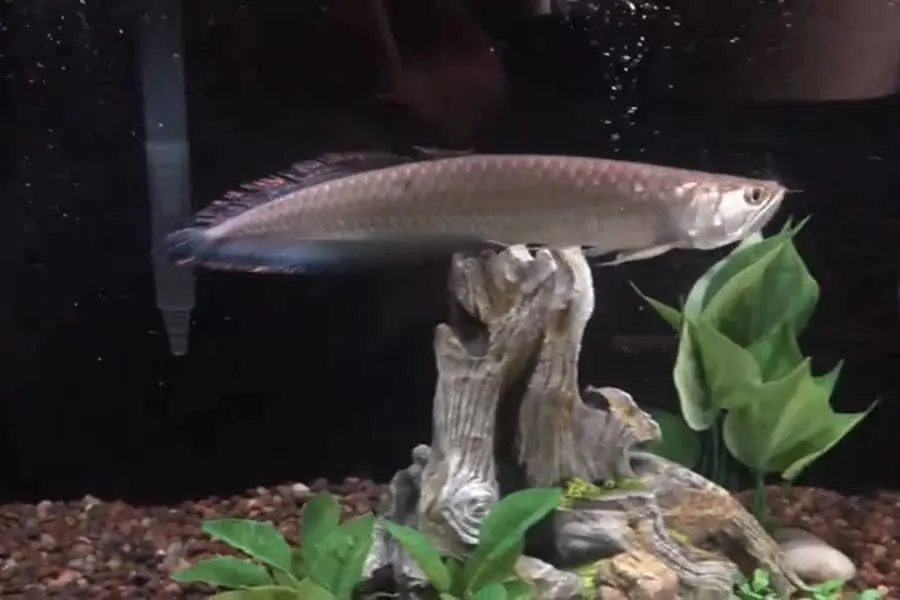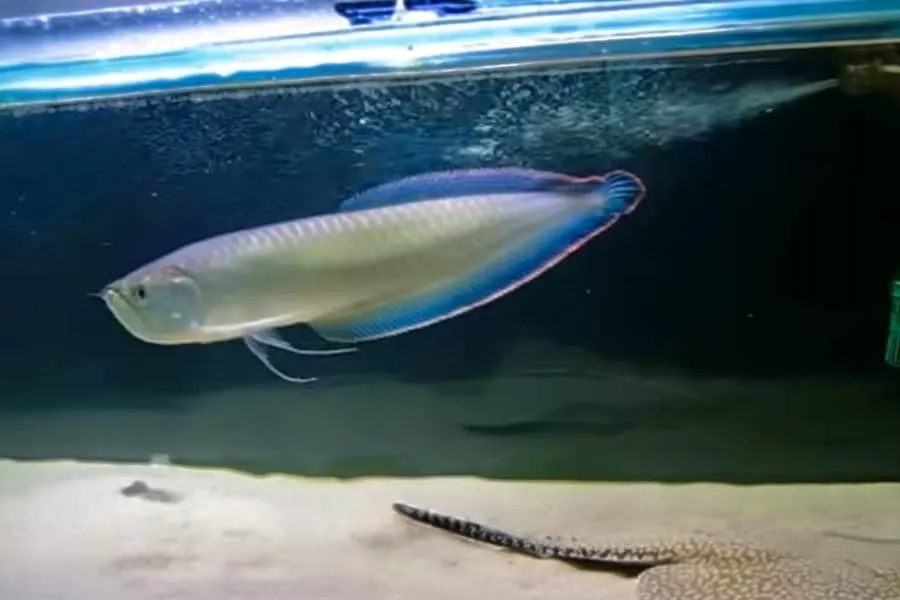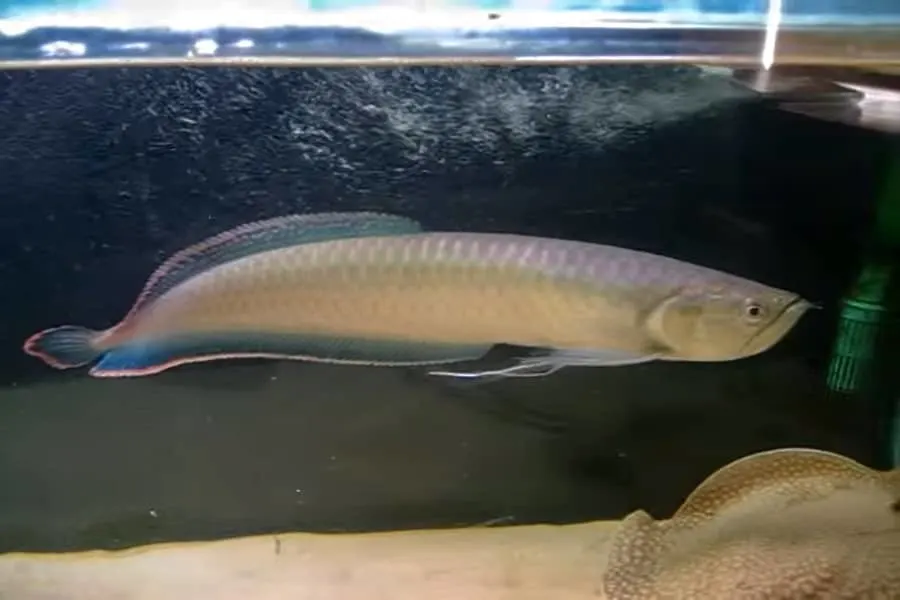This post may contain affiliate links.

The Black Arowana (Osteoglossum ferreirai) is undoubtedly the most difficult to find among the Arowana species. A mighty fish belong to the Osteoglossidae family, the same as its cousins Silver and Asian Arowana.
These fish are powerful and muscular animals, which in addition to their large size, makes them not an animal to be kept by inexperienced aquarists. The species is also susceptible to inappropriate parameters in its aquarium.
Black Arowana Overview

| Scientific name: | Osteoglossum ferreirai |
| Common names: | Black Arowana, Black Dragonfish, etc |
| Distribution: | Amazon Basin |
| Size: | 35 inches |
| Lifespan: | 20 years |
| Color: | Juvies are Black. Adults are silver |
| Diet: | Carnivore |
| Temperament: | Peaceful |
| Minimum tank size: | 159 gallons |
| Temperature: | 75–86°F (24–30°C) |
| pH: | 6.0–7.0 |
| Water Hardness: | 0-12 dGH |
| Care level: | Not for beginners |
| Breeding: | Oviparous |
Origin
These fish are native to South America in the Brazilian and Colombian parts of the Amazon basin. More specifically, in Negro and Orinoco river basins.
You can commonly find these fish near the water surface in lentic environments (low water flow). Black Arowanas habit streams and flooded forest ambients amid roots and vegetation, waiting for potential prey.
The waters they inhabit are soft and acidic, with a dark color characterized by the significant presence of tannins. The temperature is high, and the wet and dry seasons are well established, dictating the reproductive rhythm of the animals that live in that place.
This species inhabits waters with low oxygen availability. These fish also can be found in shallow waters.
Size
Black Arowana is a fish that reach large sizes. Dealing with big and strong fish like this is no easy task; this is one of the reasons that beginners shouldn’t keep this fish.
It is not common to find wild fish measuring around 35 inches. In an aquarium, we see fish that hardly exceed 30 inches in length.
Lifespan
When thinking about getting a fish like this, think long-term. These fish are very long-lived, able to live around 20 years easily.
Rest assured that you will have all the conditions to provide your pet space and quality of life.
Black Arowana Appearance

The species has the same distinctive classical form as the other Arowana species—an elongated, robust body with a sharp tail. The dorsal and anal fins follow the body’s shape, ending close to the caudal fin; this gives them the appearance of being even longer animals.
They have large positional eyes relatively high on the head. Its large mouth specializes in feeding on insects above the water’s surface, so it faces upwards.
Juveniles are black with yellow markings on the underside of their body. When they reach about 6 inches, these marks disappear, and it starts to get a slightly blue to steel gray color, hence its common name.
It may have a yellowish coloration in the dorsal,
caudal and anal fins.
Its dark color is lost as it grows, turning the fish into a dark silver color, which can be easily confused with a Silver Arowana.
Their muscular bodies and other body modifications are to aid in the great leaps these fish can make.
Colors and Patterns
Unlike their cousins, they are available in various colors and formats. The Black Arowana is only available in its wild color pattern.
Breeders from the Asian market are working on some improvement segments with this species, but they are not yet available.
Sexual Differences
Sexual dimorphism is almost invisible in the species. Adult females usually have a more rounded body and slightly shorter anal fins.
It is a tough fish to sex visually; because of this, breeders choose to perform blood tests to sex their fish correctly.
Black Arowana Behavior
These Arowana are active fish and with peaceful behavior with other fish.
Not rarely, they are seen standing, floating near the surface, waiting for some unsuspecting snack to pass. In addition, these fish are excellent jumpers, jumping to escape predators or to hunt prey.
Some scientists speculate that the Arowana has excellent eyesight and can make compensatory calculations regarding water refraction to capture food jumping out of the water.
However, studies dispute this information, indicating that they do not have such good eyesight, having a large jaw to compensate for this trait.
To launch themselves out of the water, they assume an S-shaped posture to propel themselves easily. When hunting prey underwater, it uses a different stance, starting from a position that resembles the letter C to drive itself.
These fish also hunt by ambush, hiding behind decorations and waiting for prey to pass.
This species is considered one of the least aggressive Arowana species and can live peacefully with similar-sized fish.
When kept with other Arowanas, they can show specific territoriality; caution is recommended on the part of the tutor.
These fish are easily stressed, staying quiet and denying food as a symptom.
Black Arowana Care
Because it lives in an environment that undergoes so many changes during the year, the Black Arowana is considered a hardy fish. This species can live with quality in different water patterns. These fish grow very slowly.
Despite this, we must know the specific parameters for the maintenance of the species in an ideal way, and that is what we are going to talk about now.
Black Arowana Tank Size
An aquarium with minimum dimensions of 79″x24″, something around 159 gallons, is the minimum to keep a specimen.
The most important factors for a suitable environment for the species are the length and width of the tank is of extreme importance, and it must have as much space as possible for the fish to be able to maneuver; since the body of these fish is not so flexible.
Make sure you have a quality tank with a solid and tight lid. These animals are excellent jumpers and are easily startled, making them headbutt different tank areas. This fish is so strong that it can easily break one of the glass.
Black Arowana Tank Environment (What to Put in Their Tank)
Generally, this fish is kept in two categories and two types of tanks.
The first note is that it can be kept alone or in a community tank. The second type is in tanks with and without decoration.
Remember that a community tank counts an Arowana and fish of compatible size in huge aquariums or giant ponds.
Ideally, this environment should have a particular decoration so that the animals can establish their territories and hide in aggressive cases.
Undecorated community tanks are not uncommon but should be populated with caution. In this case, you must know precisely what you are doing.
The most recommended thing is to keep the Black Arowana alone in a large aquarium. Ideally, it would be best to have a tank that mimics the biotope, an area with plants, a bed of leaves, and a lot of driftwood, with a wide-open space for swimming.
Aquariums with a decoration closer to nature will present less intense lighting, resembling that of the biotopes. Just like the water can be in a tea tone.
Many aquarists keep them alone in plain aquariums, without decoration and even substrate. These conditions focus almost exclusively on the natural beauty of the fish.
This setup may include specific lighting to enhance the characteristics of the fish.
This bare tank-style also helps with cleaning maintenance and considerably reduces the physical space you must have to predispose for a gigantic tank.
Make sure your aquarium has a filtration system to support these fish. Black Arowanas are extremely gluttonous fish, which will generate a considerable organic load.
The aquarium should have already been set up for a few months, presenting itself fully “matured.” And never forget to have a heater to ensure that the temperature is always stable and ideal for your fish.
Never keep these animals in an aquarium with alkalizing elements such as shells and rocks with the presence of carbonates. As soft water animals, they are susceptible to many salts in the water.
As much as this species is resistant, we always have to offer the best possible condition for them.
Always carry out your weekly maintenance, performing water changes and cleaning the entire tank, ensuring that there is no leftover food or debris in the aquarium.
Water parameters
These Arowana inhabit places that vary incredibly in a short period. Because of that, they can live with quality in different water parameters and types of aquariums.
As much as they inhabit a range of parameters, this species is susceptible to water quality, both to incorrect parameters as the presence of nitrogenous nutrients and bioloads.
As long as the aquarium tends towards the acidic and soft side, with a pH of 6.0 to 7.0 and a hardness of 0 to 12, your fish will have no problems related to alkalinity.
As for temperature, this fish can live well in very hot water, around 86 F, but any temperature below that, up to 75 degrees, is ok.
As much as this species is hardy and easy to maintain, given its behavioral and biological characteristics, aquarists without experience with this type of fish are not recommended as guardians.
Diseases
There is informal literature about two common diseases in the species: Drop Eye and Gill Curl.
In the first, the fish has its eyes turned downwards. Aquarists mention that this happens because the specimen looks for food in the lower zone of the aquarium, something unusual for a species that hunts on the surface. This feature is the leading cause of the eyes to “get used” to facing downwards, causing the problem.
This condition also can be caused by an incorrect diet, being fed a lot of meat, and causing it to develop fat behind the eyeball.
The second disease occurs because the fish has little room to maneuver (turn) and can damage its gills since it will have to swim backward to breathe correctly, making it more susceptible to infections.
However, they are informal reports, demanding more studies since many contradictions exist.
As larvae, these fish have a high degree of mortality—something we no longer see in adults.
Adult specimens of Black Arowana are incredibly disease-resistant fish when they are kept within the ideal parameters. Keep in mind that these are fish that are very susceptible to harmful environmental conditions.
Black Arowana Tank Mates
It is a peaceful species that will be limited to eating smaller fish.
Black Arowana are not overly aggressive (although they will occasionally hunt and attack other larger fish species), but they can become very aggressive towards their species and other Arowana species.
As this Arowana is a great predator, do not place fish with a much smaller size, as they will inevitably become food.
Avoid fish that inhabit the same swimming area as these fish, close to the surface.
Fish like Oscars, Cichlids in general, and bottom fish like Plecos, Rays, and Catfish are great tanking companions, as long as they are not aggressive and come to attack the Arowana.
As said before, this is a beautiful species to inhabit an aquarium of its own.
Black Arowana Food And Diet
It is an omnivorous fish (essentially carnivorous/insectivorous); in its natural environment, it feeds on aquatic invertebrates, eggs, and terrestrial invertebrates (Arachnida, Coleoptera, Collembola, Dermaptera, Diptera, Hemiptera, Homoptera, Isoptera, Neuroptera), shrimp and fish.
It is known locally as “monkey fish” because of its ability to jump out of the water and capture its prey. Therefore, it always swims close to the water’s surface, waiting for a potential target.
The food items in their diet are pretty extensive, including birds, bats, and snakes, but their primary diet consists of crustaceans, insects, fish, and other small animals that float on the water’s surface. Other less common snacks include crabs, snails, and even monkey droppings.
The shape of its upturned mouth is uniquely adapted for this type of feeding. This characteristic, as well as the jumping behavior, are adaptations to life in flooded forests.
When kept in aquariums, not all tutors encourage fish to feed above the water column. Instead, the fish are expected to feed on a variety of foods provided below the water’s surface.
Even though this species is the Arowana species that are more gluttonous and better accepts commercial food, in captivity, it may not readily eat dry food, requiring the supply of live and fresh food and insects.
Black Arowana Breeding
This fish is oviparous and presents parental care, and it is a buccal incubator.
For reproduction, the male will court the female, performing different lateral movements with his body, moving close to her.
If the female accepts it, the process will begin. The couple will start swimming in circles, then the female will release the eggs next to the substrate, with the male fertilizing it soon after.
Immediately after fertilization, the male holds the eggs in his mouth cavity. The male will carry the eggs in his mouth until they hatch, as will the juveniles for the next few weeks.
The reproduction of this fish in an aquarium is infrequent, with few documented cases. Among the main difficulties, we find the correct sexing of the animals and the provision of a gigantic tank (something above 800 gallons) for reproduction to occur.
Are Black Arowanas good beginner fish?
The Black Arowana can be a challenge to keep at home; proper care and minimal prior knowledge are essential for success.
If you are a fish keeper for a short time, we do not recommend this species. Other large fish species are great gateways to keeping large and specialized fish.
Black Arowana FAQs
Do Black Arowanas get lonely?
No, these fish live alone in the wild, coming together in pairs just to mate.
Will Black Arowana fight each other?
Yes, they will. Although there are reports of more than one fish in the aquarium, these fish are incredibly aggressive towards their species.
What are the main differences between Silver and Black Arowana?
The main difference is that Black Arowanas are darker and smaller. They grow incredibly slowly and can survive in milder temperatures. They are more resistant to drop-eye and are more susceptible to water quality.
Silver Arowanas are the lightest, largest, and most peaceful among the different Arowana species.
